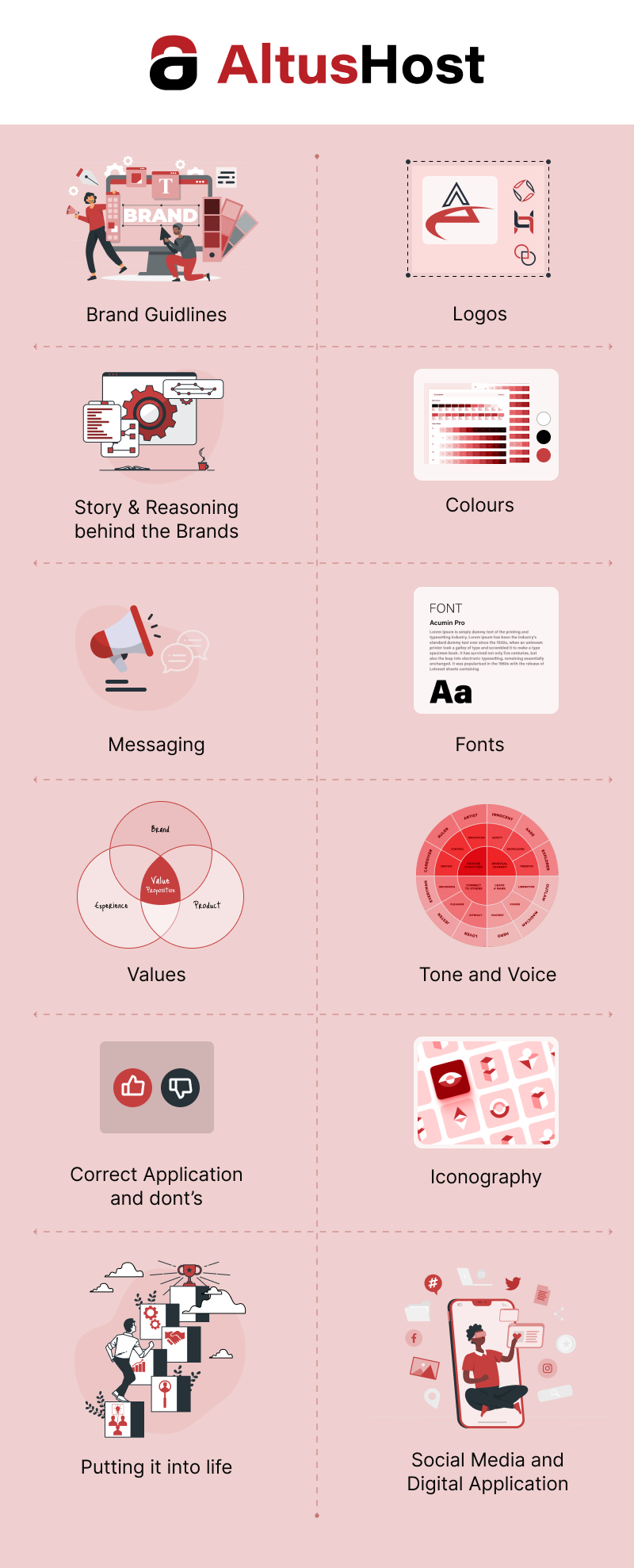Creating a cohesive and compelling brand identity is crucial for any business aiming to establish a strong presence in the market. A well-crafted brand book serves as the cornerstone of this identity, providing guidelines and standards that ensure consistency across all platforms and materials. For AltusHost, as a leading provider of reliable web hosting solutions, maintaining a strong and recognizable brand is essential to stand out in the competitive tech and marketing industry.
In this blog post, we’ll explore the essential elements that make up the perfect brand book, drawing on key components such as logos, colors, messaging, and more. We’ll also discuss how to implement these guidelines effectively, ensuring that your brand remains cohesive and impactful in every context.
Introduction
A brand book, also known as a brand style guide or brand guidelines, is a comprehensive document that outlines the rules and standards for using a brand’s visual and verbal elements. It serves as a reference for everyone involved in creating and maintaining the brand, from designers and marketers to partners and affiliates. By providing clear instructions on how to use the brand’s assets correctly, a brand book helps maintain consistency, which is vital for building brand recognition and trust.
Let’s delve into the essential elements that should be included in a brand book to create a cohesive and strong brand identity.
The following list represent various industry recommendations and best practices.
1. Brand Guidelines
Establishing the Foundation
The brand guidelines section is the foundation of your brand book. It sets the tone for the entire document by outlining the brand’s mission, vision, and core values. This section should answer the fundamental questions about what the brand stands for and what it aims to achieve.
Key Components:
- Mission Statement: A concise declaration of the brand’s purpose and primary objectives.
- Vision Statement: A forward-looking statement that describes the long-term aspirations of the brand.
- Core Values: The principles and beliefs that guide the brand’s actions and decisions.
By clearly defining these elements, one can ensure that everyone involved with the brand understands its underlying purpose and direction.
2. Logos
Versatility and Consistency
Logos are the most recognizable element of a brand’s visual identity. To maintain consistency, a brand book should include detailed guidelines on the use of different logo variations.
Key Components:
- Primary Logo: The main logo that represents the brand.
- Secondary Logo: Alternate versions of the primary logo that can be used in different contexts.
- Submark and Icon: Simplified versions of the logo for smaller applications.
- Watermark: A subtle version of the logo used for branding backgrounds or images.
- Color Variations: Guidelines on using the logo in different color schemes, including black and white versions.
Including these variations brand ensures that the logo can be effectively applied across various mediums without losing its integrity.
3. Story and Reasoning Behind the Brand
Building a Connection
The story behind the brand adds depth and authenticity. It explains the reasoning and inspiration behind the brand’s creation, helping to build an emotional connection with the audience.
Key Components:
- Brand Origin: The history and background of how the brand came to be.
- Inspiration: The ideas and concepts that inspired the brand’s visual and verbal identity.
- Evolution: How the brand has evolved over time and any significant milestones.
Sharing a story can enhance its relatability and foster a deeper connection with its audience.

4. Colors
Defining the Palette
Colors play a crucial role in brand recognition. A brand book should specify the brand’s color palette, including primary, secondary, and accent colors.
Key Components:
- Primary Colors: The main colors that represent the brand.
- Secondary Colors: Additional colors that complement the primary palette.
- Accent Colors: Colors used for highlights and accents to add depth and interest.
Providing specific color codes (RGB, HEX, CMYK) ensures that the color palette is used consistently across all digital and print materials.
5. Messaging
Crafting the Voice
Messaging guidelines define the tone and voice of the brand, ensuring that all communications are consistent and aligned with the brand’s identity.
Key Components:
- Tagline: A memorable phrase that encapsulates the brand’s essence.
- Key Messages: Core messages that convey the brand’s value proposition and unique selling points.
- Voice and Tone: Guidelines on how the brand should sound in written and spoken communications, including examples of preferred language and style.
Clear messaging guidelines help a brand maintain a consistent and recognizable voice across all touchpoints.
6. Fonts
Typography Standards
Fonts are another critical component of a brand’s visual identity. A brand book should outline the specific typefaces and typography rules to be used in all brand materials.
Key Components:
- Primary Typeface: The main font used for headings and important text.
- Secondary Typeface: A complementary font used for body text and other content.
- Typography Rules: Guidelines on font sizes, line spacing, and text alignment.
By standardizing typography it ensures that its written content is visually cohesive and easy to read.
7. Values
Guiding Principles
Brand values are the core beliefs that drive the brand’s actions and decisions. These values should be clearly articulated in the brand book to ensure that everyone involved with the brand understands and embodies them.
Key Components:
- List of Values: A clear and concise list of the brand’s core values.
- Descriptions: Detailed explanations of each value and how they influence the brand’s behavior.
Articulating values reinforces its commitment to its principles and helps build trust with its audience.
8. Tone and Voice
Consistency in Communication
The tone and voice section of the brand book provides guidelines on how the brand should communicate, both in writing and verbally. This ensures that all brand communications are consistent and reflect the brand’s personality.
Key Components:
- Voice: The overall style of the brand’s communication, whether it’s formal, casual, professional, or friendly.
- Tone: The emotional quality of the communication, which can vary depending on the context (e.g., promotional, informational, or customer service).
- Examples: Specific examples of preferred language and phrases, as well as words or phrases to avoid.
By defining tone and voice, it ensures that its communications are always on-brand and resonate with its audience.
9. Correct Application and Don’ts
Ensuring Proper Usage
A brand book should provide clear guidelines on the correct application of brand elements and highlight common mistakes to avoid.
Key Components:
- Correct Usage: Examples of how to use logos, colors, fonts, and other brand elements correctly.
- Incorrect Usage: Examples of common mistakes, such as incorrect logo placement, color misuse, or inappropriate font choices.
Providing these guidelines helps prevent inconsistencies and ensures that the brand is always represented accurately.
10. Iconography
Visual Consistency
Iconography guidelines define the style and usage of icons in brand materials. Consistent iconography helps create a cohesive visual identity.
Key Components:
- Icon Style: The overall design style of icons, whether it’s flat, outlined, or detailed.
- Icon Usage: Guidelines on when and how to use icons in brand materials.
- Examples: Examples of approved icons and how they should be used in context.
Standardizing iconography ensures that all visual elements work together harmoniously.
11. Putting It Into Life
Real-World Applications
A brand book should also include examples of how the brand identity can be applied in real-world scenarios, such as on stationery, marketing materials, and merchandise.
Key Components:
- Stationery Design: Examples of business cards, letterheads, and envelopes.
- Marketing Materials: Examples of brochures, flyers, and posters.
- Merchandise: Examples of branded items, such as mugs, t-shirts, and towels.
By showcasing these applications, it can provides a clear vision of how its brand identity comes to life in various contexts.
12. Social Media and Digital Applications
Modern Branding Needs
In 2024, a brand’s digital presence is more important than ever. Including guidelines for social media and digital applications ensures that the brand is consistently represented online.
Key Components:
- Social Media Graphics: Templates and guidelines for creating consistent social media posts and stories.
- Instagram Stickers and GIFs: Custom branded stickers and GIFs for use in Instagram Stories.
- Digital Ads: Examples and guidelines for digital advertising banners and social media ads.
Conclusion
Creating a comprehensive and cohesive brand book is essential for maintaining a strong and consistent brand identity. By including detailed guidelines on logos, colors, messaging, fonts, values, and more, a brand can ensure that its brand is represented accurately and effectively across all platforms and materials.
A well-crafted brand book not only helps maintain consistency but also builds trust and recognition among your audience. It serves as a valuable reference for everyone involved with the brand, ensuring that all communications and materials are aligned with the brand’s core identity.
Craft the perfect brand book and watch your brand thrive in 2024 and beyond and we will help you with the rest!



